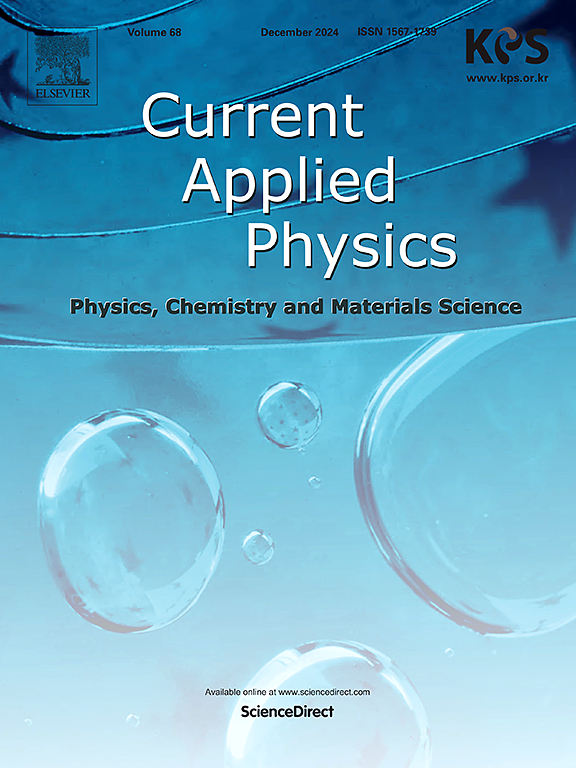Quantum phase-change materials on amorphous silicon film doped with impurities
IF 3.1
4区 物理与天体物理
Q3 MATERIALS SCIENCE, MULTIDISCIPLINARY
引用次数: 0
Abstract
The quantum phase change represents a transition to crystallizing quantum structure from amorphous silicon doped with impurities prepared in sputtering and depositing process by pulsed laser interaction, in which the silicon nanocrystals and the Yb-Er nanoalloy with direct bandgap are dramatic generated in irradiation process of laser or coherent electron beam, respectively. Here, the resonance among photon, electron and phonon occurs on surface with various impurities for quantum phase change, such as quantum dots crystallizing. It is demonstrated that the crystallizing process is faster and more stable while the plasmon energy produced by laser photon is near the phonon energy in annealing of laser irradiation, or while the energy of coherent electron is close to the phonon energy. Through quantum phase transition, the nanocrystals with various structures are observed in the TEM images, where the change characteristics in the low-dimensional quantum phase occur. It is interesting that the quantum phase change is obviously different in various impurities on surface of Si film, where the stronger condensing in crystallization doped with oxygen or erbium is measured. Under irradiation of coherent electron beam for suitable time, the nanostructure of Yb-Er alloy is observed on silicon, in which we find the new electron states near 0.93 eV for better emission at 1350 nm in the second communication window. And in the alloy of Yb-Er, the Er condensing and clustering are avoided in the crystallizing process for better emission near 1550 nm in the third optical communication window.

掺杂杂质的非晶硅薄膜上的量子相变材料
量子相变代表了脉冲激光相互作用溅射和沉积过程中制备的掺杂杂质的非晶硅向结晶量子结构的转变,其中在激光或相干电子束辐照过程中分别产生具有直接带隙的硅纳米晶体和Yb-Er纳米合金。在这里,光子、电子和声子之间的共振发生在含有各种杂质的表面上,导致量子相变,如量子点结晶。结果表明,激光辐照退火过程中,当激光光子产生的等离子体能量接近声子能量时,或相干电子能量接近声子能量时,结晶过程更快、更稳定。通过量子相变,在TEM图像中观察到不同结构的纳米晶体,其中低维量子相发生变化特征。有趣的是,硅膜表面不同杂质的量子相变明显不同,其中掺氧或掺铒的结晶凝结更强。在适当时间的相干电子束照射下,在硅上观察到Yb-Er合金的纳米结构,在0.93 eV附近发现了新的电子态,在1350 nm的第二通信窗口有更好的发射。在Yb-Er合金中,在结晶过程中避免了Er的凝聚和聚类,在第三光通信窗口1550 nm附近有更好的发射。
本文章由计算机程序翻译,如有差异,请以英文原文为准。
求助全文
约1分钟内获得全文
求助全文
来源期刊

Current Applied Physics
物理-材料科学:综合
CiteScore
4.80
自引率
0.00%
发文量
213
审稿时长
33 days
期刊介绍:
Current Applied Physics (Curr. Appl. Phys.) is a monthly published international journal covering all the fields of applied science investigating the physics of the advanced materials for future applications.
Other areas covered: Experimental and theoretical aspects of advanced materials and devices dealing with synthesis or structural chemistry, physical and electronic properties, photonics, engineering applications, and uniquely pertinent measurement or analytical techniques.
Current Applied Physics, published since 2001, covers physics, chemistry and materials science, including bio-materials, with their engineering aspects. It is a truly interdisciplinary journal opening a forum for scientists of all related fields, a unique point of the journal discriminating it from other worldwide and/or Pacific Rim applied physics journals.
Regular research papers, letters and review articles with contents meeting the scope of the journal will be considered for publication after peer review.
The Journal is owned by the Korean Physical Society.
 求助内容:
求助内容: 应助结果提醒方式:
应助结果提醒方式:


